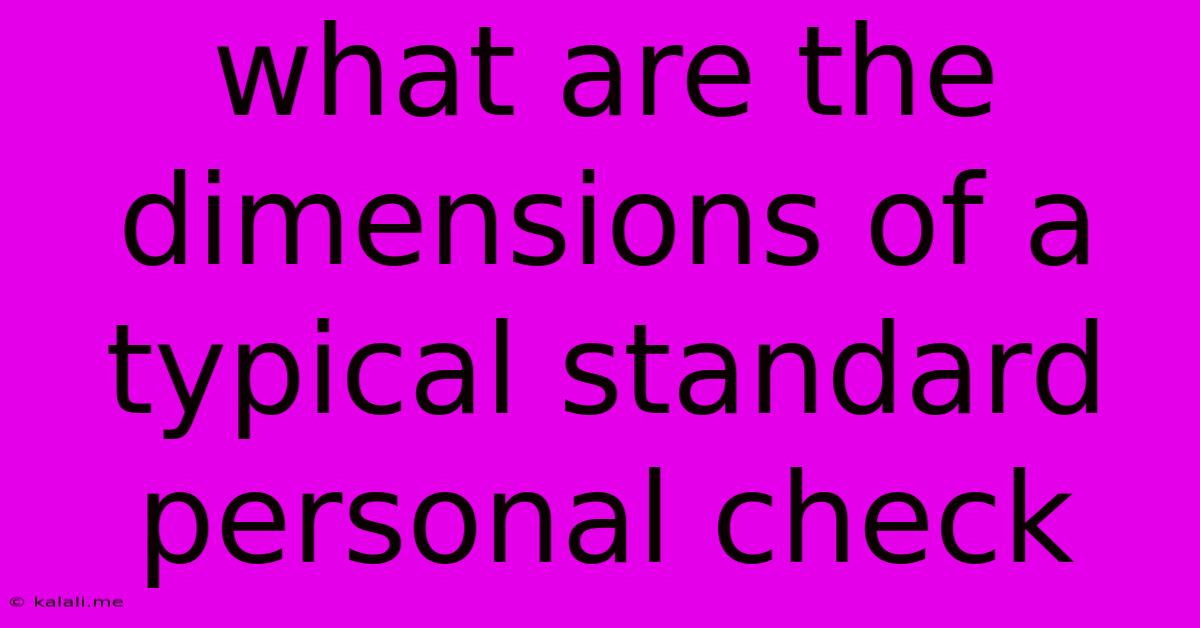What Are The Dimensions Of A Typical Standard Personal Check
Kalali
Jun 02, 2025 · 2 min read

Table of Contents
What Are the Dimensions of a Typical Standard Personal Check?
Knowing the exact dimensions of a standard personal check might seem insignificant, but it's crucial information for various reasons. Whether you're designing custom checks, creating templates for accounting software, or simply need to know for compatibility with check-writing machines, understanding the size is essential. This article will delve into the standard dimensions of personal checks in the United States and provide some context for why these dimensions are important.
Standard Check Dimensions: The US Standard
The standard size of a personal check in the United States is 3.5 inches wide by 6 inches long. This is a widely accepted and adhered-to standard by banks and check printing companies. Deviations from this size are rare and may cause issues with automated processing equipment.
Why is Check Size Standardized?
The standardization of check dimensions is vital for several reasons:
- Compatibility with Check-Writing Machines and Software: Banks and businesses use automated systems to process checks. Non-standard sizes would lead to jams, errors, and delays in processing. The consistency ensures smooth and efficient operation of these systems.
- Efficient Handling and Storage: Standardized sizes allow for easier handling, storage, and organization of checks. This simplifies banking processes and reduces the risk of misplacement or damage.
- Printing and Design: Check printing companies rely on this standard size to produce checks that are compatible with common equipment and software. This allows for streamlined production and cost efficiency.
Variations and Considerations:
While 3.5 inches by 6 inches is the prevalent standard, you might encounter minor variations:
- Slightly Larger Checks: Some checks might be marginally larger due to printing variations or the inclusion of additional features. However, these discrepancies are generally minimal and shouldn't affect compatibility with standard equipment.
- Business Checks: Business checks often follow the same standard dimensions, though they might incorporate different design elements or logos.
- International Differences: It's important to note that check sizes vary significantly across different countries. The dimensions mentioned above are specific to the United States.
Beyond Dimensions: Other Important Check Features
Beyond the physical dimensions, several other features are vital for a functional personal check:
- MICR Line: The Magnetic Ink Character Recognition (MICR) line at the bottom of the check contains essential banking information encoded in magnetic ink for automated processing.
- Check Number: Uniquely identifies each check for tracking and reconciliation.
- Routing Number: Identifies the bank where the check is drawn.
- Account Number: Identifies the specific account from which funds are to be deducted.
Conclusion
The standard dimensions of a personal check in the US are crucial for ensuring compatibility with banking systems and efficient processing. Understanding these dimensions – 3.5 inches wide by 6 inches long – is essential for anyone involved in check printing, design, or handling. Remembering these specifications is vital for avoiding compatibility issues and ensuring smooth transactions. While minor variations may exist, adherence to this standard remains the cornerstone of efficient check processing.
Latest Posts
Latest Posts
-
How To Stop Facebook From Suggesting Pages
Jun 04, 2025
-
How Do You Get Rid Of Tea Stains In Cups
Jun 04, 2025
-
Bold Vs Italics Vs Underline Vs Supernova
Jun 04, 2025
-
How To Get A Spider Out Of Your Car
Jun 04, 2025
-
What Is Chaff In The Bible
Jun 04, 2025
Related Post
Thank you for visiting our website which covers about What Are The Dimensions Of A Typical Standard Personal Check . We hope the information provided has been useful to you. Feel free to contact us if you have any questions or need further assistance. See you next time and don't miss to bookmark.